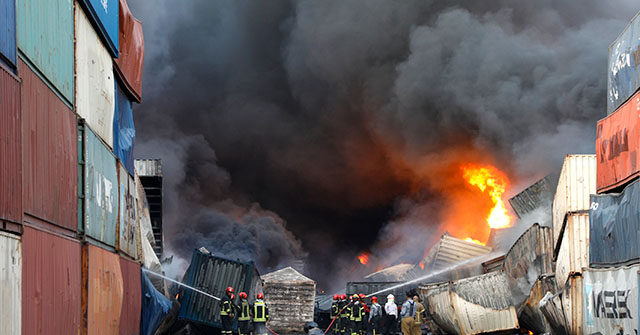The National Council of Resistance of Iran (NCRI), a dissident group based in Europe, has accused the regime in Tehran of lying about the true death toll from the massive explosions at the port of Bandar Abbas on Saturday.
According to NCRI, the regime is desperate to conceal both the cause of the explosion and the lethal incompetence of their response.
“The true death toll is several times higher than officially reported and certainly exceeds 100,” NCRI president Maryam Rajavi said on Sunday.
“The IRGC, intelligence forces, and other organs of repression have mobilized – not to contain the fires or rescue the wounded – but to control the situation and cover up the shipment of solid fuel for ballistic missiles and the full scale of the disaster,” Rajavi charged.
The IRGC is the Islamic Revolutionary Guard Corps, the theocratically-controlled wing of the Iranian military. The IRGC is a designated terrorist organization that frequently uses force to terrorize Iranian citizens into obedience.
Bandar Abbas, located in southern Iran, is home to the most important container shipping port in the country. A titanic explosion ripped through the port on Saturday, starting fires that were still burning days later.
The incident reminded many observers of the August 2020 blast at the Port of Beirut in Lebanon, a disaster for which the dysfunctional Lebanese government has yet to hold anyone responsible. The blast was almost certainly caused by poorly-stored explosive material belonging to the Iran-backed terrorist group Hezbollah.
As Rajavi indicated, international investigators suspect a similar situation occurred in Bandar Abbas. The regime mumbled something about poorly secured industrial chemicals, and vaguely hinted that foreign sabotage might have played a role.
“Our security services are on high alert given past instances of attempted sabotage and assassination operations designed to provoke a legitimate response,” Iranian Foreign Minister Abbas Araghchi said on Wednesday.
The Iranian government is not usually reticent about naming suspected foreign saboteurs. The same part of the Bandar Abbas port complex, known as Shahid Rajaei, was paralyzed by a suspected Israeli cyberattack in 2020, ostensibly launched in retaliation for an Iranian cyberattack on Israel’s water infrastructure.
According to UK-based maritime risk management company Ambrey, Bandar Abbas received a large shipment of missile fuel chemicals from China in March, in an effort to replenish the fuel Iran expended during its large but ineffective missile strikes against Israel during the Gaza war.
The specific chemical involved was reportedly ammonium perchlorate, a highly explosive powder that has few uses aside from rocket fuel.
Ambrey concluded the explosion and fire were “the result of improper handling of a shipment of solid fuel intended for use in Iranian ballistic missiles.”
The Iranian government has not officially acknowledged receiving this shipment, but an unnamed source with ties to the IRGC told the New York Times on Sunday that Ambrey’s analyst was substantially correct.
The official death toll from the Bandar Abbas explosion stood at 70 on Tuesday, with over a thousand injuries, plus tremendous financial damage from the interruption to port operations. About 85 percent of Iran’s container traffic passes through Bandar Abbas, along with a large portion of its oil shipments.
The Iranian health ministry declared a state of emergency across the entire province, instructing citizens to remain indoors as much as possible and use masks when venturing outside. Provincial governor Mohammad Ahouri Taziani said it could take up to two weeks to clean up the port enough to allow full shipping operations to resume.
Interior Minister Eskandar Momeni blamed the explosion on “shortcomings, including non-compliance with safety precautions, and negligence.” Momeni said “some individuals deemed responsible” have been brought in for questioning.
The CEO of a contractor at the port told Iranian state media that the explosion was due to “false declarations about extremely dangerous materials,” which were somehow brought into Bandar Abbas without the proper customs paperwork.
NCRI found a great deal of anger seething in Bandar Abbas on Wednesday, and suggested the populace would be doing a lot more than seething if it wasn’t unsafe for them to go outside.
“My lungs burn. My chest is tight. The air stinks of melted plastic and death. We were told to wear N95s if we go outside. But even indoors, it feels like poison,” a local resident complained.
“We found no one in our house. We came here. My daughter worked at the dock. She’s gone. They told me to pray. That’s all,” said another.
“It wasn’t food. It wasn’t textiles. It was something else. They buried it under shipping labels. And now it’s buried us,” said a third.
The large number of people who told NCRI they could not learn the fate of missing friends and relatives was one reason the dissident group concluded the real death toll from the explosion ran into the hundreds.
“For Iran’s younger generation – the ones burying parents and friends this week – Bandar Abbas may become a turning point. Not just a wound, but a warning. A final indictment of a regime that can no longer distinguish between defending the nation and destroying it,” NCRI predicted.
Read the full article here


